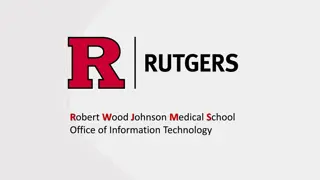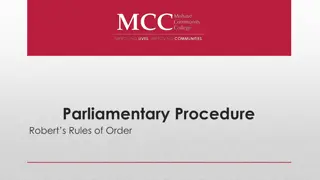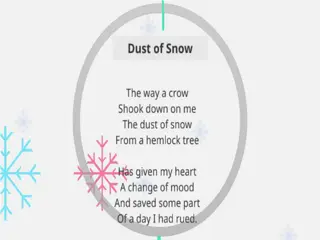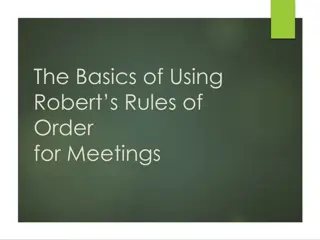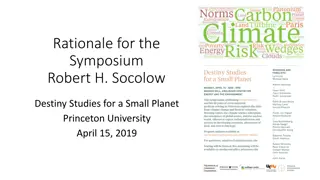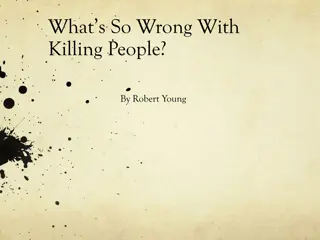
Insights on COVID-19 Vaccination Behaviors and Predictors
Dive into the research conducted by Robert Hornik's COVID-19 research lab at the Annenberg School for Communication, University of Pennsylvania. Explore vaccination outcome measures, intention-to-be-vaccinated trends, and predictors of vaccination status. Understand the impact of communication interventions on vaccination decisions. Gain valuable insights into age-related patterns and correlations with vaccination behavior.
Download Presentation

Please find below an Image/Link to download the presentation.
The content on the website is provided AS IS for your information and personal use only. It may not be sold, licensed, or shared on other websites without obtaining consent from the author. If you encounter any issues during the download, it is possible that the publisher has removed the file from their server.
You are allowed to download the files provided on this website for personal or commercial use, subject to the condition that they are used lawfully. All files are the property of their respective owners.
The content on the website is provided AS IS for your information and personal use only. It may not be sold, licensed, or shared on other websites without obtaining consent from the author.
E N D
Presentation Transcript
Robert Hornik COVID-19 research lab (Leeann Siegel, Kwanho Kim, Chioma Woko Emma Jesch, Ava Kikut, Danielle Clark) Annenberg School for Communication University of Pennsylvania rhornik@asc.upenn.edu
Three components of this talk The study and the vaccination outcome measure Background interesting results Results specific to potential communication interventions
The study Nationally representative adult sample (SSRS opinion panel): online and phone Three waves of same respondents T1 May 2020: n=1074 T2: June 2020: n=889 T3: April/June 2021: n=750 (70% retained) Weighted to Current Population Survey, major demographics
Vaccination outcome status measures Intentions (T1, T2, T3) If you were able to get a vaccine for coronavirus today, what is the likelihood that you would get vaccinated? Very likely Somewhat likely Somewhat unlikely Very unlikely Behavior (T3 only) Have you received at least one dose of any of the COVID-19 or coronavirus vaccines? No/Yes Are you now fully vaccinated? No/Yes
Vaccination outcome variables Variable % somewhat or very likely 67% 63% % somewhat or very unlikely 33% 37% Intentions T1 Intentions T2 Yes 57% No 43% At least 1 vaccine dose T3 74% 26% At least one vaccine dose or somewhat or very likely T3
Intention strongly predicts behavior one year later when vaccines available. 67% Intention T1 (April 2020) % Very likely 90% % Somewhat likely 82% % Somewhat unlikely 65% % very unlikely 38% At least one vaccine dose or somewhat or very likely T3 (April- June 2021 Yes 74% 10% 18% 35% 62% No 26% 40% 27% 13% 20% N=748
Part 2: Background predictors and correlates of vaccination status at T3 (April/June 2021)
Most of the predictors of who will get vaccinated (or be likely) in June are as expected: Age Age 18-29 30-49 50-64 65+ 68% 70% 76% 84% At least one vaccine dose or somewhat or very likely T3 (April- June 2021 Yes 74% 32% 30% 24% 16% No 26% 21% 34% 25% 21% N=746 Gamma= .223
Most of the predictors of who will get vaccinated (or be likely) in June are as expected: Education Education HS or less Some college 73% College grad 85% 66% At least one vaccine dose or somewhat or very likely T3 (April- June 2021 Yes 74% 34% 27% 15% No 26% 38% 28% 34% N=746 Gamma= .343
Most of the predictors of who will get vaccinated (or be likely) in June are as expected: Metro area Metro residence Metro Non-metro 79% 64% At least one vaccine dose or somewhat or very likely T3 (April- June 2021 Yes 76% 21% 36% No 24% 81% 19% N=692 Gamma= .357
Most of the predictors of who will get vaccinated (or be likely) in June are as expected: Currently insured Insured? No Yes 50% 77% At least one vaccine dose or somewhat or very likely T3 (April- June 2021 Yes 74% 50% 23% No 26% 12% 82% N=748 Gamma= .544
Most of the predictors of who will get vaccinated (or be likely) in June are as expected: Religious identity Age None/othe r 80% Catholic Other Christian 68% 81% At least one vaccine dose or somewhat or very likely T3 (April- June 2021 Yes 76% 20% 19% 32% No 24% 38% 28% 34% N=746
Most of the predictors of who will get vaccinated (or be likely) in June are as expected: Political Party Age Republican Democrat Independe nt 70% 65% 84% At least one vaccine dose or somewhat or very likely T3 (April- June 2021 Yes 74% 35% 16% 30% No 26% 26% 37% 31% N=741
Misinformation items (T1-Spring 2020) Information about treatments for coronavirus is being suppressed by those who want the pandemic to continue Coronavirus was created in a lab The coronavirus is not more dangerous than the seasonal flu Coronavirus is probably a hoax Public health authorities are exaggerating the seriousness of coronavirus A vaccine for the coronavirus is now available The malaria drug Hydroxychloroquine is an effective treatment for coronavirus A cure for coronavirus has been found Coded 1:strongly disagree, 5: strongly agree; Cronbach s alpha summed scale=0.84
Association of T1 misinformation & T3 vaccination outcome
Support for government restriction items (T1-Spring 2020) The federal/state government should restrict the gathering of people to stop the spread of the coronavirus. The federal/state government should provide small businesses financial support to keep them afloat until it is safe to reopen The federal/state government should give financial support to individuals until it is safe to go back to work The federal/state government should consider public health more than economic risks when setting policies about the coronavirus The federal/state government should be allowed to force people into self-isolation if they are infected The federal/state government should require that anyone in public places wear a face mask The federal/state government should move quickly in loosening restrictions on businesses (reversed) The federal/state government should allow most businesses to re-open even if there is some risk to health (reversed) Coded 1:strongly disagree, 4: strongly agree; Cronbach s alpha summed scale=0.84
Association of T1 Government restrictions & T3 vaccination outcome
But then there are some less obviously expected results
Most of the predictors of who will get vaccinated (or be likely) in June are as expected: but not Sex Sefl-reported gender Male Female 74% 74% At least one vaccine dose or somewhat or very likely T3 (April- June 2021 Yes 74% 26% 26% No 26% 48% 52% N=749 Gamma= .01
Black respondents lower on vaccination outcome, but only if they are young At T1: Black respondents were less very likely to intend to be vaccinated than non-Black respondents: 23% vs. 43% By T3: the overall difference in our vaccine outcome measure was minimal: 71% versus 74%. But there was still a striking difference, but only among young respondents
Among the unvaccinated: an expected mandate is influential Expect Mandate No Yes All measures at T3, Asked: Do you think you will be required to get vaccinated against the coronavirus to return to work, to school or for another reason this year? 27% 63% Somewhat or very likely to be vaccinated T3 (April- June 2021 Yes 40% 73% 37% No 60% 64% 36% N=317
Part 3: results relevant to communication interventions
Major decisions when considering communication interventions What beliefs to focus on Who should be the sources for messages What should specific messages look like How to diffuse messages to assure repeated exposure (Given limited time, the rest of my comments will focus on the first of these decisions.)
Some candidate beliefs for campaign focus Efficacy for protecting self Descriptive norms- are others doing it? Efficacy for protecting others Subjective norms do others expect you to do it? Other benefits for oneself Costs of vaccination Concerns about being exploited Safety - long term Trust in public health sources Safety short term
How much potential effect on intention would a campaign focused on each belief have? You would be protecting your family and close friends from getting infected Strongly Disagree disagree agree Average outcome Gain in outcome Somewhat Somewhat Strongly agree % vaccinated or likely 20% 22% 80% 98% 74% 24% Proportion of sample expressing level of agreement 10% 13% 33% 44%
Two versions of this belief assessment analysis A set of beliefs that we measured at T2: how well do they predict the vaccination outcome at T3, adjusting for Intentions at T2? A larger set of beliefs we measured at T3: how strongly are they associated with the vaccination outcome?
We look at 6 beliefs measured at T2? Which of them predict vaccine status in 2021, beyond intentions T2? Percentage to gain you could trust information you receive from public health officials about the vaccine you would be well protected from getting infected with the coronavirus you would be protecting others in your community from getting infected 21% 18% 17% you would suffer bad side effects from the vaccine (disagree) 14% 14% it would be a financial burden (disagree) you could be a test subject for a vaccine with unknown consequences (disagree) -8%
We look at beliefs measured in 2021? Which are associated with vaccine status? Safety and Efficacy Safety for self (e.g) Percentage to gain You would experience serious side effects for longer than a few days (disagree) 25% Efficacy for self (e.g.) Percentage to gain You would be well protected from getting seriously ill from the coronavirus You would be well protected againstnew variants of the coronavirus 22% 20% Efficacy for others (e.g.) Percentage to gain You would be protecting your family and close friends from getting infected 24%
We look at beliefs measured in 2021? Which are associated with vaccine status? Norms Descriptive Norms Percentage to gain 14% How many of your four closest adult friends or family members have received at least one dose of a COVID-19 vaccine? (3 or 4) Subjective norms Percentage to gain Do most people who are important to you approve of you getting vaccinated against the coronavirus? 10%
We look at beliefs measured in 2021? Which are associated with vaccine status? Other examples Percentage to gain Drug companies are pushing vaccination just to make a lot of money (strongly disagree) 22% The companies that developed the vaccines worked too fast (strongly disagree) How do you feel about the possibility that you or someone in your immediate family might catch the coronavirus? (very worried) 19% 17% It was/would be difficult to sign up for a vaccine appointment 4% You would not have to wear a mask or social distance in public places -2%
Implications 1 Intentions really do predict behavior 12 months later Our data supports the association of the expected predictors: age, education, metropolitan residence, religious affiliation, political party, misinformation, concerns for government regulation. Gender does not appear to be associated, and race is associated only for young people (a change since T1.) The mandate appears to hold promise.
Implications 2 We describe a method for choosing which beliefs merit more and less attention for communication interventions. By and large the common foci for campaigns [safety for self; efficacy for self and others; trust in public health sources] are supported in these analyses Some other potential campaign targets [e.g. concerns with being a test subject, the promise of going mask free, the ease of signing up] are less promising. Financial issues are inconsistent.




